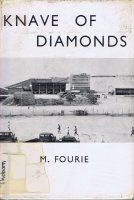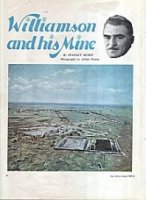Dr John Thoburn Williamson
John Thoburn Williamson was born in Montfort, Quebec on the 10th February 1907, the second of four children. His father, Bertie J Williamson, owned a lumber yard, and was a Scot who had emigrated to Canada from Ireland. His mother, Rose C Boyd was of French extraction. The family moved to Montreal in 1919 where John went to the Macdonald high school at Ste Anne de Bellevue. From there he entered McGill University in 1925 where he studied law. but a summer field expedition to Labrador inspired him to switch to geology. He gained a BA degree with honours in 1928, followed by the Leroy memorial fellowship in geology in 1929, a bursary of the National Research Council in 1930/31 and became a demonstrator in geology and mineralogy. He graduated with an MSc in 1930 followed by a PhD in 1933. His former Professor of Geology, Dr Richard Graham, was invited to Johannesburg to inspect some land De Beers wanted surveying. Williamson accompanied Dr Graham and gave a few lectures at the University of Witwatersrand. JTW was invited to join Loangwa Concessions, a subsidiary of De Beers Consolidated Mines, as a field geologist which he accepted. The company was prospecting for copper in north-east Rhodesia, close to Tanganyika. Williamson approached De Beers for a grant along with a licence to prospect for diamonds in Tanganyika but was refused and so he resigned.
Williamson took a position with the Tanganyika Gold and Diamond Development Company in 1935, working under their chief geologist, Hank Le Tendresse, an American whom JTW eventually succeeded.
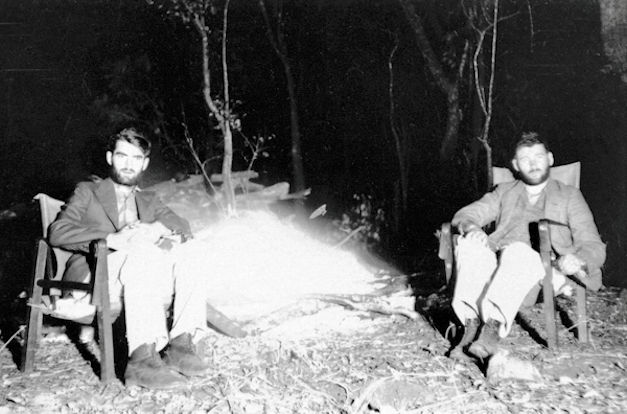 In May 1936 Williamson traveled to Mwanza seeking out a flamboyant Asian Lawyer, Mr Iqbal Chand Chopra KC. They met on 16th May 1936; "Dr John Thoburn Williamson, was ushered into my front room office lined with glass-covered bookcases. In white shirt and khaki trousers he sat in front of the broad wooden desk, a pen set and an ink pot, an elegant clock encased in an intricately carved box from Gujranwala, and an ashtray he filled with cork tipped ‘Craven A’ butts. He wanted the legal affairs of an independent prospector to be sorted and he needed financing. The search for diamonds, though, entailed the range of skills and capacities of both of us, we understood perseverance for wholly different reasons, and had been groomed by circumstances for this meeting. In friendship, we shook on more of an adventure than a commercial venture."
In May 1936 Williamson traveled to Mwanza seeking out a flamboyant Asian Lawyer, Mr Iqbal Chand Chopra KC. They met on 16th May 1936; "Dr John Thoburn Williamson, was ushered into my front room office lined with glass-covered bookcases. In white shirt and khaki trousers he sat in front of the broad wooden desk, a pen set and an ink pot, an elegant clock encased in an intricately carved box from Gujranwala, and an ashtray he filled with cork tipped ‘Craven A’ butts. He wanted the legal affairs of an independent prospector to be sorted and he needed financing. The search for diamonds, though, entailed the range of skills and capacities of both of us, we understood perseverance for wholly different reasons, and had been groomed by circumstances for this meeting. In friendship, we shook on more of an adventure than a commercial venture."
Iqbal Chand Chopra had been in partnership in Dar-es-Salaam with Gulam Rusal, a barrister from Lahore. In 1929 they established a law practice in the vacant Africa Hotel in Nkoma Street, Mwanza, on the ground floor.
Rusal passed away leaving Iqbal to continue the practice alone. He got by making a living from his caseload of both civil and criminal cases.
Left: Richard Roberts and John Thoburn Williamson the diamond seeker, prospecting with Loangwa Concessions, a De Beers subsidiary, in nortrhern Rhodesia, now Zambia, in the early 1930's
In 1937 the Tanganyika Gold and Diamond Development Company suspended operations and JTW was free to go it alone. Chopra backed JTW and started a lifelong friendship. He surveyed all over the Lake and Western Provinces without much luck. He then took a sub-lease on the Mabuki diamond mine, the oldest in the territory which did not yield much either. However he had pegged a few finds nearby and another at Kizumbi. He hypothesized that the stones he had found over a wide area must have come from a central point somewhere in the Lake Province. He persevered out in the bush with two faithful African Native boys, Issa and James . JTW was prone to attacks of Malaria and other illnesses but never gave up his search. The League of Nations had mandated Britain to govern German East Africa following their defeat in WWI. Britain declared war on Germany on 3rd September 1939. The Italians had sided with Germany and were fighting the allies in north africa. There was always a fear that they would turn on East Africa but never did.
On the 6th March 1940 Williamson set out from his camp at Kizumbi to go with James to see where he had found a diamond on his journey back from his village. Suddenly James said "Iko Hapa, Bwana, Iko hapa!" (It is here boss, it is here). Williamson set up a field camp by a baobab tree close by while Issa and James set about panning some gravel. That day they excavated more diamonds and Williamson realised he had found his volcanic pipe at last.
Williamson needed to survey the pipe without raising any suspicion, he spent months digging trenches and then backfilling them on his covert survey mission. Mr I C Chopra was the only person he could trust to deal with staking his claim. Meanwhile Canada had it's first taste of war with their troops defending Hong Kong. The news of the atrocities meted out by the conquering Imperial Japanese Army filtered through and Doc was deeply disturbed by it. Years later he found that one of his employees had defended Hong Hong alongside the Canadian troops and escaped as the atrocities were taking place on Christmas Day 1941, Williamson Diamonds Limited was registered in Dar es Salaam in May 1942 with £20.000 divided into 400 shares at £500.00 each, Williamson kept 299 and gave 100 to his brother Percy. The other one share was for his friend and backer I C Chopra. He named the site Mwadui after a local tribal chief. The rest, as they say, is history.
With the backing of the Mwanza lawyer, Iqbal Chand Chopra KC, Williamson began excavating the diamonds with a task force of local labour. Later he was able to use Italian POW's to operate the limited heavy plant he managed to purchase. By 1946, he had several thousand workers with families living at Mwadui, and had formed an auxiliary security force comprised of Askari's under the command of European officers. The force numbered 250 to protect his budding empire. He had found the largest diamond deposit ever, the oval-shaped volcanic pipe which was filled with diamondiferous ore covered some 251 acres on the surface; more than four times larger than any of the diamond pipes found in South Africa. The British Colonial Office advised Williamson of the urgent need for industrial diamonds. Diamond smuggling was rife in the early days, several packets of diamonds had been known to reach Germany before the allies could put a stop to it. During the war years Williamson was a major contributor to the British treasury.
His two faithful native helpers, Issa and James, who were with him through his years of prospecting were given substantial pensions for life and retired to where Doc had been based, close to the site of the old Kabuki Mine.
Mwadui is a source of high value Type II diamonds and impressive pinks. Williamson was selling his diamonds on the open market causing De Beers to become increasingly concerned about its ability to control world prices. The corporate minutes of De Beers on June 20, 1946, reflect this growing apprehension. Sir Ernest Oppenheimer the chairman said that he was sure that a satisfactory outcome would result from negotiations with the British Colonial Office over a prospecting license for De Beers, but he said that the position would not be secure until they were able to come to terms with Williamson. He mentioned that the Tanganyika production was now one and one-half million pounds per annum. He very much doubted whether, at the moment, he had 65 percent effective control of world production. Oppenheimer pointed out that this uncontrolled production could prove embarrassing if there was an economic recession, and he recommended, according to the notes of the meeting, "that their efforts should be energetically directed towards obtaining effective control of all African production".
The diamond sights in London proved to be one effective means of reasserting control of the Mwadui diamonds. Williamson had to sell his low quality as well as the high quality diamonds to the diamond cutters in order for his mine to be in profit. Most of the major cutting factories, especially for the more difficult-shaped diamonds, were clients of De Beers. When these clients came to the London sights, they were told, according to reports reaching the U.S. Department of justice, that they should not buy any of Williamson's
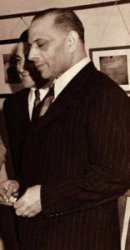 diamonds. The threat was
implicitly made that they might find their consignment drastically reduced or
even abruptly ended if they bought any diamonds from Williamson. Since few of
the cutting factories in Antwerp were willing to risk their sight in London by
violating this rule of the game, Williamson found that he could only sell the
clear, octahedron crystals that were in demand by small, independent
cutters. He had to store most of the clear diamonds. This severely squeezed his
cash reserves.
Following lengthy negotiations Williamson signed a five year contract with the Diamond Corporation, controlled by De Beers in 1948. Williamson now agreed to produce upto 10%, by value, of the total world output distributed by the syndicate. Williamson was now part of the arrangement. Diamonds earned,at that time, more foreign exchange for Great Britain than almost any other export.
diamonds. The threat was
implicitly made that they might find their consignment drastically reduced or
even abruptly ended if they bought any diamonds from Williamson. Since few of
the cutting factories in Antwerp were willing to risk their sight in London by
violating this rule of the game, Williamson found that he could only sell the
clear, octahedron crystals that were in demand by small, independent
cutters. He had to store most of the clear diamonds. This severely squeezed his
cash reserves.
Following lengthy negotiations Williamson signed a five year contract with the Diamond Corporation, controlled by De Beers in 1948. Williamson now agreed to produce upto 10%, by value, of the total world output distributed by the syndicate. Williamson was now part of the arrangement. Diamonds earned,at that time, more foreign exchange for Great Britain than almost any other export.
Williamson was not comfortable with the arrangement and three years into the five year contract started to withhold his diamonds from the corporation, preferring to stockpile his output, a gamble to force a better deal.
Left: Mr I C Chopra KC
Photos from Jarat Chopra ©
In March 1952 Ernest Oppenheimer sent his son Harry, with a legal team, to Mwadui to negotiate a deal with Dr Williamson. Doc hired the distinguished barrister Mr Gilbert Paul KC to represent him alongside his legal partner Mr Iqbal Chopra KC. At the conclusion Doc was openly jubilant at the outcome saying there was to be a new agreement that would be beneficial to both parties. Doc proceeded to make secure arrangements to transfer his stock to Mwanza, five flights in all. With his diamonds now moving Doc was able to finance an innovative new plant incorporating the latest standards. Fraser & Chalmers pty in Johannesburg were contracted to build the new plant, supplying all necessary labour. His "big expansion" program got underway in ernest.
Mwadui was a model mining town without equal at the time, built for miners and their families with modern amenities such as schools, hospitals and recreational facilities.
The processed diamonds were stored in a reinforced building, the four locks had their combinations changed every 24 hours and the keys were kept by four separate executives. inside the diamonds were graded by an expert valuer and stored in two of the three safes within. The third contained cash for the wages of the mine operatives.The secure area was guarded twenty four hours a day. Doc alone decided when and how many diamonds were to be flown to Mwanza. The Chief Security officer was given notice, he in turn would call the pilot giving him thirty minutes notice. At Mwanza they were transported in a company land rover to the bank. From there they would be flown to London. Williamson's output averaged three hundred and fifty carats per day.
The mine was also a training ground for many young scientists. Williamson relied heavily on Canadian talent to transform his discovery into one of the world’s largest diamond mines. Fortunately for Canada, many of them later returned home to train, mentor and inspire a new generation of diamond industry professionals. Bert Gerryts PhD, MSc, BSc had also graduated from McGill university, was the Senior Geologist at Mwadui 1951-58. He is now a consultant geologist with Karelian Diamond Resources
Harry F Oppenheimer said "When that difficult Canadian, Williamson, was causing us some anxiety about the uncontrolled sales of his diamond output in Tanganyika, my father chose me to go and negotiate with him. He snubbed me at first, but in the end we had our way."
Left: Harry Oppenheimer, representing De Beers, arriving in Mwadui in March 1952 to negotiate with Dr Williamson to end his dispute with the Diamond Corporation.
Photo from the Burgess family collection ©
Bwana Williamson was diagnosed with throat cancer in 1956 and eventually died of it at 3 o/c in the morning on the 8th January 1958 just a few days before his 51st birthday. He was buried that same afternoon in the cemetery where it all began at his beloved Mwadui. His brother, Percy a shareholder, along with his two sisters, Mrs Miller and Mathilda Williamson, inherited the the mine, they had no mining experience and immediately began negotiations via Mr I Chopra to sell Mwadui.
Williamson Diamonds Limited was sold 50/50 to De Beers and the Tanganyika Government on the 13th August 1958 for £4,159,000 GBP. JTW's effects in England amounted to £5,823 18s 7d which was left to I C Chopra. Harry Oppenheimer was appointed Chairman and held the post for fifteen years. As a politician Harry also represented Kimberley in South Africa for the United political party. Chopra's son Gerald later became a partner with his father in Mwanza trading as Chopra and Chopra.
Harry Oppenheimer presented James with a medal, on behalf of De Beers, in recognition of his role in discovering Mwadui.
Williamson supported numerous causes but avoided publicity, one such cause he supported was Makerere University in Kampala, Uganda where he was a benefactor. Makerere was first established as a technical school in 1922..
Dr John Thoburn Williamson, was inducted into the Canadian Mining Hall of Fame in 2011
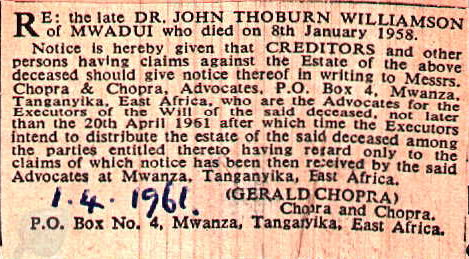
References
Inside Africa; John Gunther 1955
The Diamond Seeker; Heinz Hedgen. 1959
Williamson Diamonds Limited a brief history; De Beers1960
Diamonds Unlimited; Percy Burgess 1960
Knave of Diamonds; Mona Fourie 1962
The Diamond Seeker; John Garwain 1976
Indiaqua; Gay Du Toit, 23rd April 1979
Williamson, John Thoburn (1907-1958); I C Chopra revised by Marryna Fraser. 2004
Origins of a Passage to East Africa; Jarat Chopra AWAAZ Vol 6 issue 2. 2009
Princess Margaret Hosted in Mwanza; Jarat Chopra Old Africa, Stories from East Africa's past. Issue. 22 April-May 2009
A Diamond Diggers anecdotes And stories; Bert Gerryts 2016
My Story
It was three days and two nights flying from London to Nairobi. The plane was a
Vickers Viking with seating for about 27 passengers, and
flying was daytime only. The first leg was to Nice for refueling and lunch. Then it was onto our overnight destination Malta where encountering a severe electrical storm en-route.
The following day was onto Cairo where we enjoyed our first taste of curry and coca cola as there had been rationing back home with no sugar available for luxury drinks. After lunch it was on again to Khartoum where we stayed in a floating hotel on the (Blue) Nile. The desert was something to
wonder at for me. The following morning it was on to Nairobi where we stayed with friends for five days. I still have my air
ticket from Airworks [ £48.10 shillings ].
From Nairobi it was a short flight to Mwadui in Doc's VIP De Havilland Dove [in the cockpit for me] with Mike Croft at the controls.
Dad (Bud Hide) had flown out three months earlier and was there to meet us off the plane. I made the mistake of jumping into the back of an open topped Land Rover, never ever made that mistake again. It was a short drive to our new semi detached bungalow in Hopley Avenue, the centre of the five pairs on the golf course side. The Johnson family lived next door in the other part of our semi, with the school teachers Freda Dent and Jacquie Harvey sharing the next semi, and Louis Staalberg, a radio ham, in 29, the last before the golf coarse.
The famous Williamson Pink (54.5 carat rough) was found on the surface in 1947 by two local native boys, they took it to the Doc's house. Dr Williamson gave the priceless cut Pink round [23.6 carat] to the then Princess Elizabeth as the centerpiece of a brooch for her forthcoming wedding to Prince Phillip.
[ 142 carat's = 1imperial oz]
Dr Williamson died of throat cancer in January 1958, and was buried in Mwadui. The Mine was taken over by his brother Percy B Williamson & Mr I C Chopra the Asian Lawyer who financed his early days prospecting. Mr Chopra held a 10% stake in the mine from day one. We also left Mwadui in 1958, shortly after the Doc's death and returned to England after one last flight to Nairobi in the Dove. We stayed with relatives in Nairobi for a while before getting the over-night train to Mombassa. Here we used to go swimming in the clear waters of the Indian Ocean at Nyali beach. Then it was back to England by ship, The Braemar Castle of the Union Castle Line. I then went to join my elder brother at the Royal Hospital School in Holbrook, Suffolk.
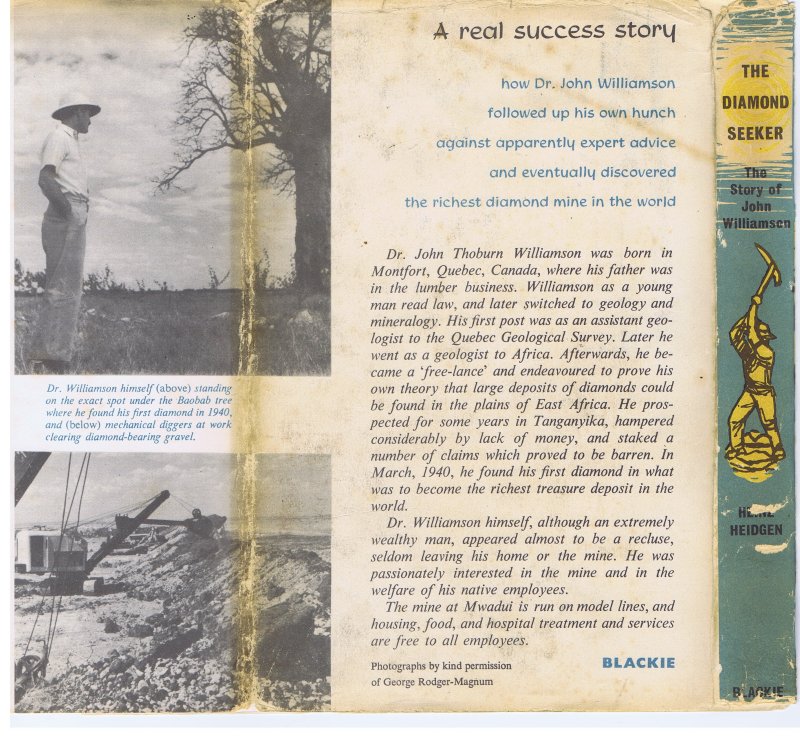
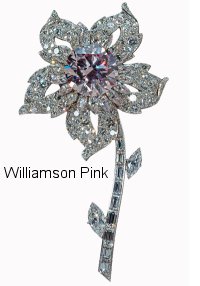
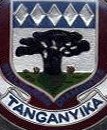
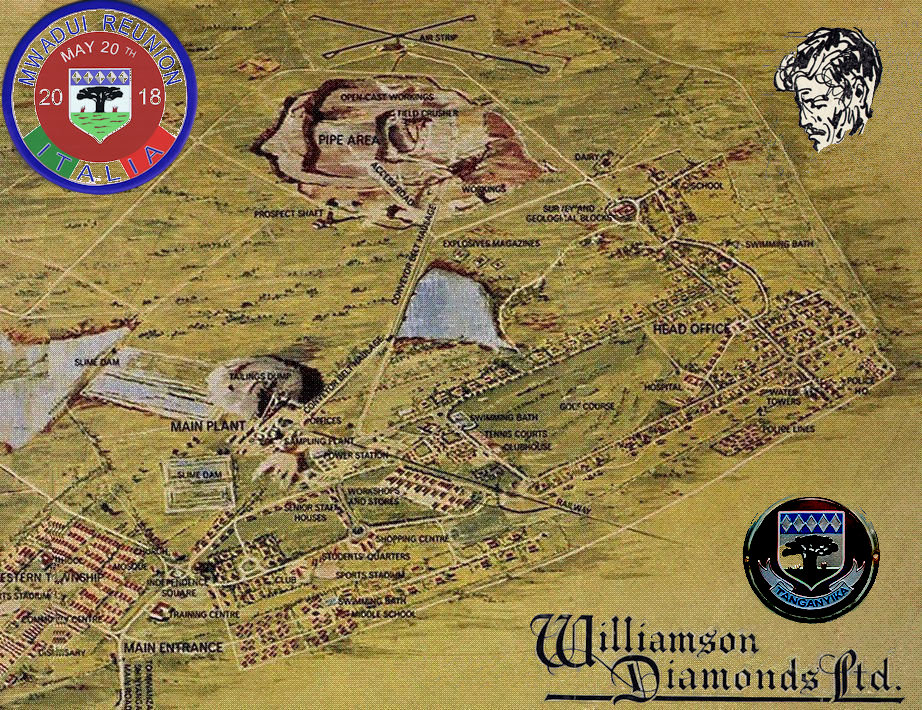
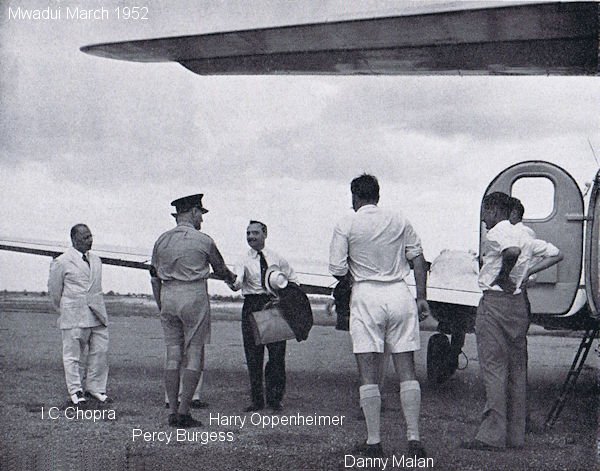
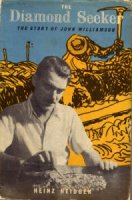 The Diamond Seeker by Heinz Hedgen. First published in Austria in 1955 as The Diamantensucher in Tanganjika by Verlag Stria, Graz in German. This translation by Isabel and Florence McHugh was published by Blackie & Son Ltd in London in 1959. Although of the same title as Gawaine's book it is not the same.
The Diamond Seeker by Heinz Hedgen. First published in Austria in 1955 as The Diamantensucher in Tanganjika by Verlag Stria, Graz in German. This translation by Isabel and Florence McHugh was published by Blackie & Son Ltd in London in 1959. Although of the same title as Gawaine's book it is not the same. 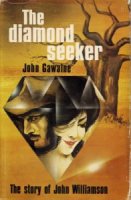 The Diamond Seeker by John Gawaine was published by Macmillan South Africa (Publisher's) (PTY) Ltd in 1976. (ISBN 0 86954 029 7)The author, who writes under a nom-de-plume, was educated at Dulwich College, England. He was seconded from his regiment into the Special Operations Executive (SOE} during the war. He was involved in Intelligence & Commando operations in North Africa, Sicily, Yugoslavia, & Greece, reaching the rank of Lieutenant Colonel. After the war he & his wife emigrated to East Africa, Then in 1968 they moved to South Africa where he was engaged in Industrial research.
The Diamond Seeker by John Gawaine was published by Macmillan South Africa (Publisher's) (PTY) Ltd in 1976. (ISBN 0 86954 029 7)The author, who writes under a nom-de-plume, was educated at Dulwich College, England. He was seconded from his regiment into the Special Operations Executive (SOE} during the war. He was involved in Intelligence & Commando operations in North Africa, Sicily, Yugoslavia, & Greece, reaching the rank of Lieutenant Colonel. After the war he & his wife emigrated to East Africa, Then in 1968 they moved to South Africa where he was engaged in Industrial research.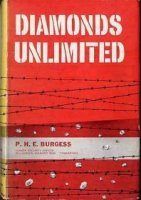 DIAMONDS UNLIMITED by P.H.E. BURGESS
DIAMONDS UNLIMITED by P.H.E. BURGESS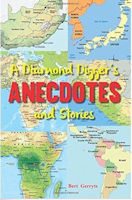 A Diamond Digger's Anecdotes by Bert Gerryts
A Diamond Digger's Anecdotes by Bert Gerryts